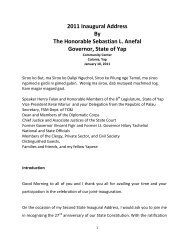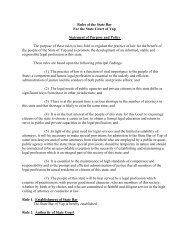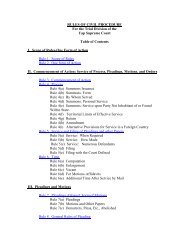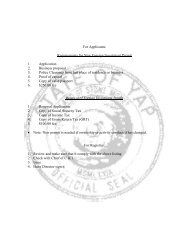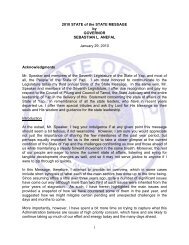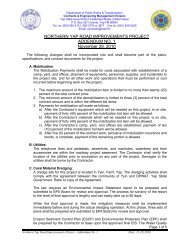CORRIGENDUM No. 2 - Yap State Government
CORRIGENDUM No. 2 - Yap State Government
CORRIGENDUM No. 2 - Yap State Government
You also want an ePaper? Increase the reach of your titles
YUMPU automatically turns print PDFs into web optimized ePapers that Google loves.
power point trackers (MPPT) have become available. This section determines how to size the PV array based<br />
on switched controllers based on the PV array meeting the daily load requirements all year. Later in the guide<br />
is a section on how to size a PV array using a MPPT.<br />
The size of the PV array should be selected to take account of:<br />
seasonal variation of solar irradiation<br />
seasonal variation of the daily energy usage<br />
battery efficiency<br />
manufacturing tolerance of modules<br />
dirt<br />
temperature of array (the effective cell temperature)<br />
Solar irradiation data is available from various sources. Some countries have data available from their<br />
respective meteorological department. One source for solar irradiation data is the NASA website:<br />
http:/eosweb.larc.nasa.gov/sse/. RETSCREEN, a program available from Canada, incorporates the NASA<br />
data and it is easier to use. Please note that the NASA data has, in some instances, had higher irradiation<br />
figures than that recorded by ground collection data in some countries. but if there is no other data available it<br />
is data that can be used.<br />
Solar irradiation is typically provided as kWh/m 2 however it can be stated as daily peak Sun Hours (PSH). This<br />
is the equivalent number of hours of solar irradiance of 1kW/m 2 .<br />
Attachment 1 provides data on the following sites:<br />
• Suva, Fiji (Latitude 18°08 ′S Longitude 178°25 ′E)<br />
• Apia, Samoa (Latitude 13 o 50' S' Longitude 171 o 44' W)<br />
• Port Vila, Vanuatu (Latitude 17° 44' S Longitude 168° 19' E)<br />
• Tarawa, Kiribati (Latitude 1°28'N, Longitude 173°2 'E)<br />
• Raratonga, Cook islands( Latitude 21°30'S, Longitude 160°0'W)<br />
• Nuku’alofa, Tonga (Latitude 21º14'S Longitude 175º22'W)<br />
• Honiara, Solomon Islands (Latitude 09°27'S, Lon gitude 159°57'E)<br />
• Koror ,Palau ( Latitude 7°20’N Longitude 134°28'E)<br />
• Ponapei, Pohnpei FSM (Latitude: 6°54'N, Longitude : 158°13'E)<br />
• Majuro, Marshall Islands (Latitude: 7º 12N, Longitude 171º 06E)<br />
• Alofi, Niue (Latitude 19°04' S. Longitude 169° 55' W)<br />
• Nauru (Latitude 0º55’S, Longitude 166º 91’E)<br />
• Tuvalu (Latitude 8°31 ′S, Longitude 179°13 ′E)<br />
• Hagåtña, Guam (Latitude 13°28 ′N Longitude: 144°45 ′E)<br />
• <strong>No</strong>umea, New Caledonia (Latitude 22°16 ′S Longitude: 166°27 ′E)<br />
• Pago Pago, American Samoa (Latitude 14°16 ′ S Longitude: 170°42 ′W)<br />
The variation of both the solar irradiation and the load energy requirement should be considered. If there is no<br />
variation in daily load between the various times of the year then the system should be designed on the month<br />
with the lowest irradiation that is peak sun hours (PSH).<br />
DAILY ENERGY REQUIREMENT FROM THE PV ARRAY<br />
In order to determine the energy required from the PV array, it is necessary to increase the energy from the<br />
battery bank to account for battery efficiency.<br />
.<br />
The average columbic efficiency (in terms of Ah) of a new battery is 90% (variations in battery voltage are not<br />
considered).<br />
For the worked example the daily energy requirement expressed in Ah from the battery is 74 Ah. Allowing for<br />
the battery efficiency, the solar array then needs to produce…<br />
74 Ah ÷ 0.9 = 82.2 Ah<br />
Assume the worst months PSH is 5.<br />
Issue 1 September 2012 Page 7



